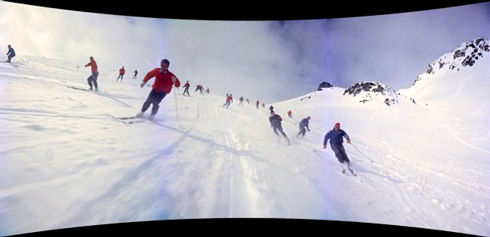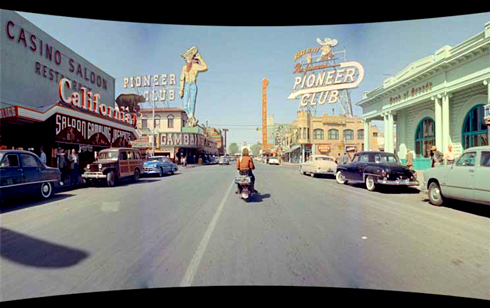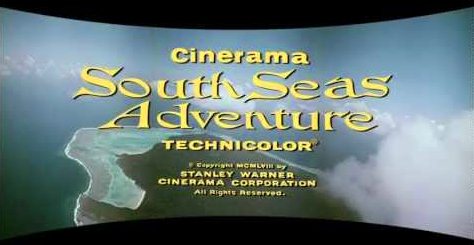|
|
Reviewed by Glenn Erickson
Talk about a major job of filmic restoration. The giant 3-panel Cinerama format had been extinct for quite a while when a handful of collectors here and overseas began putting together unique private mini-Cinerama theaters, complete with the three-projector setup. The actual filmic holdings of the Cinerama Corporation had been languishing in storage for decades, with no assurance that they would ever again see the light of theatrical exhibition. Pacific Theaters inherited this vault, and also owned Hollywood's Cinerama Dome, which ironically had never seen 3-panel projection during the Cinerama era. In stepped a small group of Hollywood professionals led by editor-enthusiast technical expert David Strohmaier, to promote the idea of refurbishing all of the Cinerama features. Strohmaier was an important consultant on the restoration of Warners' MGM-produced How the West Was Won. What's more, Strohmaier came up with the clever concept of 'Smilebox' formatting for video. Theatrically, Cinerama plays on a curved screen and really can't have the same impact when imaged flat. The use of the Smilebox (see the posted images) simulates the curvature of the theatrical experience, and also helps to correct perspective mismatches between the three panels.
Last year the disc label Flicker Alley released Strohmaier's restored Blu-rays of the original This Is Cinerama and a travelogue called Windjammer. Just out are two new discs that represent even more complicated restorations: the second Cinerama release Cinerama Holiday (1955) and the fifth, 1958's Cinerama South Seas Adventure. The movies are fascinating, as are the stories behind them as told through the plentiful disc extras. Each disc is a separate purchase.
This Is Cinerama was in concept little more than a novelty film that searched for likely subjects for the costly, ungainly but undeniably impressive 3-panel Cinerama format. Content-wise the film was a step back to 1895, when just seeing things in a visual format was in itself thrilling. This Is alternated exciting point-of-view experiences (the roller coaster, in particular) with travelogue vistas and performances. Produced by the noted Louis De Rochemont, the second major production Cinerama Holiday applies a simple framing idea to what is still a travelogue format, eliminating deadly sequence ideas such as six-minute shots of a choir singing. The producers found an American couple to travel to Europe, and a Continental couple to take an extended American holiday. They hired two young attractive married couples, the Marshes from the Midwest and the Trollers from Switzerland. It doesn't hurt that they all look like catalog models. The European Fred Troller was an experienced artist. The movie shows highlights of their vacation travels, ranging all over the United States in the case of the Trollers, and for John and Betty Marsh visiting big cities and Alpine snow country. Highlights include a ride down a bobsled run (complete with realistic sound in 7-track stereo) and a trip to Paris for the Americans, while the Trollers travel across the country on a tiny motorcycle (um-hmm, sure) visiting big cities and Las Vegas, which impresses them even though it is but four or five square blocks of relatively modest casinos. The itineraries jump all over the place, from San Francisco back to New England and then down to New Orleans. Music and performances sneak in through skaters and clowns up in the Alps, and a Dixieland band in The Big Easy. The two couples finally come together in New York, to see the 'premiere' of the film they've just created. Seated in a Cinerama theater, they watch a concluding spectacle of Navy jets flying in formation and landing and taking off from an aircraft carrier.

Cinerama Holiday is exactly what it sounds like, a superficial travelogue that impresses through its unique cinematography -- audiences loved feeling as if they were there in the white snow atop an Alpine mountain. The same goes for a slow trucking shot along the Seine, where we see the river on one side and the looming Notre Dame cathedral on the other. For us video viewers 60 years later, the many wide shots of Parisian boulevards and Swiss roads are fascinating in themselves� that's how it was. It's a strange blend: primitive cinema made with ultra-sophisticated technology.
Cinerama is the oddest, most unwieldy film format ever, but it indeed grabbed major attention worldwide for about ten years. Scores of dedicated theaters were built (even in Havana, Cuba!) just to show Cinerama on a Road Show, hard ticket basis. Audiences marveled at the colossal curved screen. A patron sitting way down in front (not necessarily recommended) had to turn his head radically from left to right to follow action on the screen -- quite a bit of one's peripheral vision was covered.
Conveying the Cinerama experience on home video is a tall order: no matter what one does, the visual field in Cinerama is fairly distorted. Strohmaier's "Smilebox" concept works quite well on the How the West Was Won Blu-ray and is a big boost to these releases. Although the Smilebox doesn't quite compare to the real thing, its simulated 'wrap-around' screen conveys a similar sensation.

The extras for Cinerama Holiday are many and thorough. Betty Marsh and Beatrice Troller are tapped for an interview featurette, and Betty thumbs through a scrapbook that she kept during her European trip. It must have been great, being "forced" to wait for weeks in a fancy Paris hotel for the next filming assignment. Added fun is provided by outtakes from an earlier docu in which cameramen tell stories of working with the Cinerama camera, including unforeseen accidents filming on ski slopes, etc.. A surviving breakdown reel, to be used if (heh heh) anything should go wrong with the outrageously complicated, interlocked apparatus needed to project Cinerama, is a 15-minute 35mm reel that has the Marsh's pull out their photo album to "fill in".
Cinerama Holiday is of course meant to be light entertainment escapism. If anything, it inspired a lot of Americans in the audience contemplating European tours of their own. The overall tone and a few lines of narration show a touch of Cold War attitude. America is presented as equal to the rest of the world put together. When the Marshes say they want to avoid tourist destinations in Paris, a local expert answers that "the tourists here go everywhere but the city dump and the Russian embassy". A couple of lines about the Free World sneak in as well. Everybody beams with pride at the exhibition of military superiority that concludes the show -- there's no question of who owns the world.
Made three years later, Cinerama South Seas Adventure breaks from the straight travelogue format. The show no longer pretends that the Cinerama camera can magically follow its attractive characters, or that what we see is necessarily what they see. We're given one omniscient narrator -- Orson Welles -- to lend majesty and mystery to South Seas scenery and aerial shots of lonely atolls. Various 'characters' come to the Pacific to find something special, and some of their voices provide additional narration. The actor-models slightly stiff play-acting looks more real than the earlier film's feigned reality. South Seas Adventure is shorter but has more shots and more visual variety.
Two young women Kay Johnson and Marlene Hunter (Diane Beardmore & Marlene Lizzio) take a Matson Liner to Oahu. Marlene plans to marry, and Kay is entertained by Marlene's blonde brother Ted (Tommy Zahn), who takes her on a tour of the islands and Honolulu's favorite nightspot, Don the Beachcomber's. Penniless French artist Jean-Louis Martin (Igor Allan) enlists to crew on the sailing yacht Te Vega. He's hazed when they cross the equator, and in Tahiti he visits Paul Gauguin's neighborhood and paints pictures of an exotic dancer, Turia (Ramine). The voyages of the philosophical skipper Amos Dorn (Ed Olsen) provide opportunities to visit other islands deep in Polynesia, especially one where young men jump from wooden towers with vines attached to their ankles to prove their bravery. An ex-GI looking for peace finds it fishing in New Zealand, a land that seemingly gathers landscapes from all over the world. European refugees David and Anna Koschek (Eric Reiman & Jannice Dinnen) are welcomed to a new home in the barren Australian outback, where the government encourages immigration. And we return to Hawaii for a fancy island wedding.

South Seas Adventure is a much more fluid and expressive experience than Holiday. So many of us have visited Honolulu that it's amazing to see the city before its beach was studded with fifty hotels, and traffic was (until quitting time) fairly reasonable. From the Punch Bowl the South coast is laid out before our eyes from Diamond Head to the entrance to Pearl Harbor ... we can see the Aloha Tower, the image is so sharp. The politics is rather careful in this show. Except for shots of the resting place of the Arizona, nothing is mentioned about the massive U.S. military presence on Oahu. The Punch Bowl is actually a vast military graveyard up in the hills. By this time there was already a Cinerama theater in Tokyo.
The movie takes every opportunity to give us aerial views of volcanoes, sailing ships on the vast ocean, appealing uninhabited islands and big expanses of New Zealand mountain scenery. We see plenty of tourist-oriented native dancing and extended scenes of surfing at Waikiki (a pro team for sure, complete with a surfing dog). In Tahiti, the movie gives the impression that there are hundreds of beautiful Polynesian women waiting in flowered sarongs to pose for handsome French painters. The Christian influence is charted in shots of missionary churches and a couple of excerpts of local choirs. Aerial shots of a New Zealand town are quick to pick out a new church for special coverage. The narration touches upon a few facts of Polynesian history before taking on the story of the relocation of the Koschek father and daughter to a wind-scow sheep ranch in the middle of Australia. It's not spelled out that the Koscheks have fled Communist tyranny, but we can connect the dots. When the narrator asks how young Anna will get along without any other children around for hundreds of miles, the mini-drama shows a radio being used to conduct long-distance schooling. Good luck, kid.
South Seas Adventure has been called the most attractive of the Cinerama presentations, mainly because of the photogenic subject matter. The color is in better shape, and lovers of tropical paradise imagery will feel quite at home. The film delivers the pre-existing fantasy of the South Seas, while adding an unusual item here and there. One chaotic shot of dozens of kangaroos leaping past the camera is especially fun. The most dramatic attraction is the scene with the natives doing their death-defying proto- bungee jumps off those towers. At least one of them seems to hit the dirt when there is still slack in the vines tied to his ankles... but he gets back up on his own. This scene made an indelible impression on children back in '58. 1

Adding immeasurably to the experience is Alex North's music score, along with the mysterioso choral effects arranged by Norman Luboff. Other songs of the region are sourced in the Hit Parade of the 1920s and '30s. The extras include an interview with the daughter of producer Carl Dudley and another with one of the production staff, and Carl Dudley's promotional film about South Seas Adventure. A full commentary is present, with historian David Coles and Ramine Seaman, the actress-dancer seen in the movie. And another restored short subject in full Cinerama (and Smilebox) is a promotional item for the Renault Dauphine car, showing the workings of the assembly line.
Both discs come with restoration docus that are nothing less than fascinating. They start with a brief explanation of the Cinerama process, and then delve into the problems of reconstructing the three panels for each picture, transferring them to video and aligning the inter-panel blends. That last task seems a daunting one; the Image Trends company was responsible for creative transfer engineering and software to digitally manipulate the three panels. David Strohmaier explains how they tried to compensate for uneven density that produces hot spots. They corrected as much as possible the distortions of the process -- remember, each panel is a separate exposure with a separate wide-angle lens that exhibits a slight barrel distortion. The Smilebox format helps make some of these mismatches look better. The alignment of the "joins" on the digital video is better than what projected Cinerama was able to achieve.
Flicker Alley's (separate release) Deluxe Combo Blu-ray + DVD Editions of Cinerama Holiday & Cinerama South Seas Adventure are impressive collector's items, perfect for owners of large monitors or projectors to show guests something truly exotic. The restored color looks good on Holiday and very good on South Seas Adventure, even when sections of the films had to be recovered from less than optimal sources.
Each title comes with a Blu-ray and DVD disc, both of which carry all the extras. Also included are printed reproductions of the original Road Show souvenir programs.
On a scale of Excellent, Good, Fair, and Poor,
Cinerama Holiday & Cinerama South Seas Adventure Blu-ray rates:
Movies: Very Good ++
Video: Excellent it's a miracle they can be seen, so a few flaws don't count; color is better on South Seas Adventure.
Sound: Excellent (2.0 and 5.1 STS-HD Master.
Supplements: Many, see above.
Deaf and Hearing-impaired Friendly?
N0; Subtitles: none.
Packaging: One Blu-ray and one DVD disc with souvenir booklet in keep case
Reviewed: November 10, 2013
Footnote:
1. My mother took me to South Seas Adventure in downtown Honolulu probably in early 1959 -- these shows routinely played a solid year. I remembered most of the show in vague terms, but the vine-jumpers blew my little eight-year-old mind. Those had to be the bravest men on the planet. How could I prove that I was brave? Is that how one becomes a man, by doing something incredibly dangerous?
Return

DVD Savant Text © Copyright 2013 Glenn Erickson
See more exclusive reviews on the Savant Main Page.
Reviews on the Savant main site have additional credits information and are often updated and annotated with reader input and graphics.
Also, don't forget the
2011 Savant Wish List.
T'was Ever Thus.
Return to Top of Page
|

